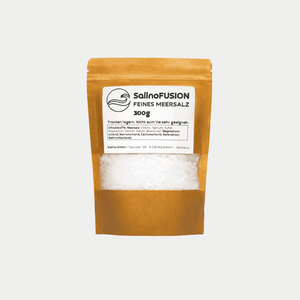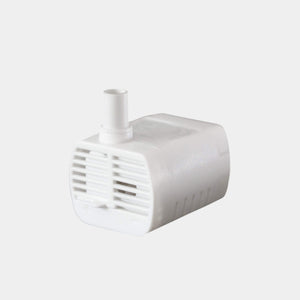A pet moves in – and with it a new chapter
Later, we often remember the day our first pet arrived. Perhaps it was the wide-eyed puppy from behind the kennel gate, the curious paw of a cat, or the gentle trembling of a newly adopted guinea pig in our arms. These are moments filled with anticipation—and responsibility.
A pet changes more than just the daily routine. It brings life into the home, demands care, and creates closeness. But how can this start be achieved so that humans and animals don't just live side by side, but truly bond? And what does it take to create a home that offers security, peace, and health—also from your pet's perspective?
This question takes us deeper into the design of the indoor environment, the quality of the air, the understanding of animal needs and even the role of humidity and salinity in the living area.
In this article, we'll walk you through five ways you can give your new companion a gentle, healthy, and loving start—emotionally approachable, scientifically sound, and full of real-life insights.
1. Letting it all begin: Why peace is more important than toys
 For many pet lovers, the big day begins with excitement: the new basket has been chosen, toys are ready, maybe even the first collar. But in the initial phase after moving in, your pet needs one thing above all else: time and space.
For many pet lovers, the big day begins with excitement: the new basket has been chosen, toys are ready, maybe even the first collar. But in the initial phase after moving in, your pet needs one thing above all else: time and space.
The first encounter – from an animal perspective
Animals experience new environments with a different sensory system than we do. Smells, sounds, and vibrations are crucial for them. What seems cozy to us—a television in the background, scented candles, a honking van—can be frightening to your pet. Dogs and cats in particular, but also rabbits, birds, and rodents, are very sensitive to stimuli.
A new beginning therefore doesn't begin with activity, but with slowing down. Give your pet a safe place to retreat —a quiet room, a blanket under the table, a cozy den away from the hustle and bustle. Let it observe, orient itself, and take in scents.
Rituals instead of sensory overload
Young or rescued animals in particular benefit from clear, recurring routines. Feeding times, small greeting rituals, the same bedtime song – what may seem banal to us provides security for your pet. Avoid inviting many visitors or taking your pet everywhere with you during the first few days. Instead: offer quiet attention, a presence without demands.
This phase lays the foundation for trust. And trust is the currency with which your relationship grows over the long term.
2. Rooms with feeling: Thinking about the living environment from an animal perspective
 Most homes are designed with humans in mind—at eye level, comfortable for our movements, and based on our aesthetic preferences. But when a pet moves in, this perspective changes. In the truest sense of the word.
Most homes are designed with humans in mind—at eye level, comfortable for our movements, and based on our aesthetic preferences. But when a pet moves in, this perspective changes. In the truest sense of the word.
Orientation on four paws
Imagine your home from the perspective of a small dog or cat. The world suddenly consists of huge furniture, slippery floors, noisy household appliances, and a multitude of smells that are barely noticeable to us. Many animals—especially those from shelters—react to this abundance of stimuli with insecurity or overwhelm.
The power of quiet zones
Every animal needs zones: areas for sleeping, eating, playing—and areas that are off-limits. Rooms often don't appear as a unified whole to animals, but rather as a series of odorous islands. When your pet begins to choose its own "favorite spots," observe it carefully. Sometimes your pet will tell you more about good placements than any interior design book.
And: less is more. Don't clutter rooms, but create room to move around. Safe, non-slip access to resting areas is especially crucial for older animals. Carpets, rugs, or mats can work wonders – even for nervous paws.
3. Sounds, smells, habits: How stimuli work – and what they have to do with behavior
 A human hears a vacuum cleaner and knows it's about to be over. An animal hears it and only understands it's loud, threatening, and uncontrollable. Stimuli that seem trivial to us can trigger deep discomfort in pets.
A human hears a vacuum cleaner and knows it's about to be over. An animal hears it and only understands it's loud, threatening, and uncontrollable. Stimuli that seem trivial to us can trigger deep discomfort in pets.
Low-stimulation instead of low-stimulation
Animals are not decorations for everyday life, but fully-fledged living beings with a sensory apparatus that is often more refined than ours. Especially in dogs and cats, the sense of smell plays a key role; in birds, it's light and sound; and in rodents, vibration and proximity are the primary sensors.
What does this mean for your home?
- Noises : Washing machines on spin cycle, rattling doors, or a constantly running television can all cause anxiety. Learn to incorporate moments of silence—not only for your pet's relaxation, but also for yourself.
- Odors : Strong cleaning products, scented candles, or perfumes often have a repulsive effect on animals. A "fresh scent" for us can be a real irritant for animals. Instead, opt for neutral or natural cleaning products – and pay particular attention to the feeding area: It shouldn't come into contact with cleaning chemicals .
- Light and movement : Many animals orient themselves according to changes in light. Dark corners can have a calming effect—as long as they aren't too narrow. Motion detectors or flashing LEDs, on the other hand, can be perceived as a threat.
Space also means: right of retreat
A pet needs a place where it can be left alone. No playing, no petting, no talking. Just being there. Children, especially, need to learn that this place is off-limits. A simple trick: Mark the resting place—with a cloth, a sign, or simply with your words.
Because animals can learn – but they need clear, respectful signals.
4. Air for Life: How indoor climate and breathing quality shape your pet's well-being
 You can't see it, you can barely taste it – and yet it's omnipresent: the air we breathe. For pets, who often spend many hours a day indoors, the quality of this air is crucial – yet often overlooked.
You can't see it, you can barely taste it – and yet it's omnipresent: the air we breathe. For pets, who often spend many hours a day indoors, the quality of this air is crucial – yet often overlooked.
Why animals breathe differently – and react differently
Dogs and cats breathe faster than humans, filter pollutants less effectively, and are more sensitive to pollen, house dust, or dry heating air. Small animals such as rabbits and birds sit with their noses directly next to their bedding—and are thus exposed daily to fine particles, ammonia fumes, and dryness. Older animals or those with pre-existing conditions are noticeably more sensitive to this.
Dry air can lead to irritated mucous membranes, frequent sneezing, coughing or even chronic respiratory diseases – as well as restless behavior if the animal simply feels unwell.
Create a microclimate – for you and your pet
Healthy indoor air doesn't start with technology, but with mindfulness: Ventilation, regular cleaning without irritating fragrances, pet-friendly plants, and avoiding sources of dust are simple but effective measures. Humidifiers without ultrasound can also help—many animals react to ultrasound with restlessness or stress.
Still little known, but effective: salty air. Studies in human medicine demonstrate its beneficial effects on the respiratory tract and mucous membranes. What many people don't know: animals can also benefit from a slightly salty indoor climate – especially if they suffer from allergies, are susceptible to infections, or have dry indoor air.
A quiet solution: mini saltworks in everyday life
If you want to do something for your pet's long-term well-being, a mini saline can be a quiet helper. These devices generate saline ambient air without any mist or noise – a passive, filterless application that is pleasant and well-tolerated for both humans and animals. Especially in the winter months or in homes with little air circulation, this is a gentle way to actively improve the indoor climate.
Conclusion: A home that connects – for heart, paw and breath
A first pet brings joy, responsibility—and often uncertainty. What does it really take? How do you create an environment that's not just practical but also emotionally supportive?
In this article, we've explored five approaches that are more than just checklists: They invite you to see your home from your pet's perspective. It's about trust instead of speed, calm instead of sensory overload, air quality instead of decoration, and closeness that takes its time. Those willing to observe, understand, and rethink the space will be rewarded – with a deeper sense of connection.
Because a good coexistence doesn't begin with the equipment, but with the care. If you see your pet as a sentient being, as a roommate on equal terms, a whole new world opens up to you. One in which small rituals have a big impact, in which breaks become meaningful, in which breathing counts.



